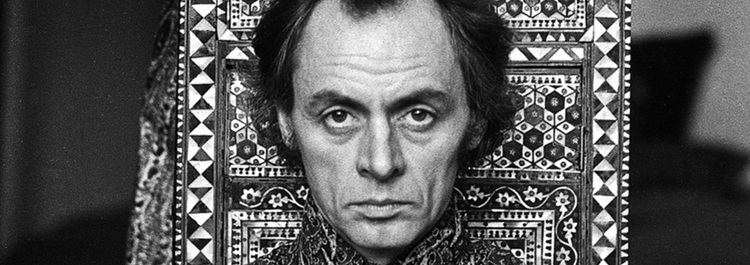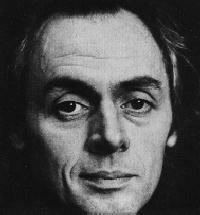Fields Psychiatry Influences Eugene Minkowski | Name R. Laing | |
 | ||
Influenced David AbramLoren Mosher Spouse Jutta Werner (m. 1974–1986), Anne Laing (m. 1952–1966) Children Adrian Charles Laing, Susan Laing, Fiona Laing, Adam Laing Books The Divided Self: An E, The Politics of Experien, Sanity - Madness - and the F, Self and Others, The Politics of the family Similar People Aaron Esterson, Luke Fowler, Jean‑Paul Sartre, Gregory Bateson, Melanie Klein | ||
1970s Interview R D Laing on Kingsley House, Mental Illness
Ronald David Laing (7 October 1927 – 23 August 1989), usually cited as R. D. Laing, was a Scottish psychiatrist who wrote extensively on mental illness – in particular, the experience of psychosis. Laing's views on the causes and treatment of serious mental dysfunction, greatly influenced by existential philosophy, ran counter to the psychiatric orthodoxy of the day by taking the expressed feelings of the individual patient or client as valid descriptions of lived experience rather than simply as symptoms of some separate or underlying disorder. Laing was associated with the anti-psychiatry movement, although he rejected the label. Politically, he was regarded as a thinker of the New Left.
Contents
- 1970s Interview R D Laing on Kingsley House Mental Illness
- R D Laing and Asylum 40 Years Later THE NEW SCHOOL
- Early years
- Career
- Laing and anti psychiatry
- Personal life
- Works
- Influence
- Books on Laing
- Films and plays about Laing
- References

R. D. Laing and Asylum 40 Years Later | THE NEW SCHOOL
Early years

Laing was born in the Govanhill district of Glasgow on 7 October 1927, the only child of David Park MacNair Laing and Amelia Glen Laing (née Kirkwood). Laing described his parents – his mother especially – as being somewhat odd. Although his biographer son largely discounted Laing's account of his childhood, an obituary by an acquaintance of Laing asserted that about his parents – "the full truth he told only to a few close friends".
He was educated initially at Sir John Neilson Cuthbertson Public School and after four years transferred to Hutchesons' Grammar School. Described variously as clever, competitive or precocious, he studied mainly Classics, particularly philosophy, including through reading books from the local library. He was also a musician, being made an Associate of the Royal College of Music. He chose to go on to study medicine at the University of Glasgow. During his medical degree he set up a "Socratic Club", of which the philosopher Bertrand Russell agreed to be President. Laing failed his final exams on his first attempt, in 1950, but, after spending six months working on a psychiatric unit, passed them in a subsequent re-sit at the start of 1951.
Career
Laing spent a couple of years as a psychiatrist in the British Army Psychiatric Unit at Netley, part of the Royal Army Medical Corps; conscripted despite his asthma that made him unfit for combat, where he found an interest in communicating with mentally distressed people. In 1953 Laing left the Army and worked at the Glasgow Royal Mental Hospital, becoming the youngest consultant in the country. Isabel Hunter-Brown, who worked at the hospital at the same time as Laing, suggests that the Glasgow approach to mental illness, and many of Laing's ideas, were influenced by the work of David Henderson, who in turn credited the American Adolf Meyer. During this period Laing also participated in an existentialism-oriented discussion group in Glasgow, organised by Karl Abenheimer and Joe Schorstein.
In 1956 Laing went on to train on a grant at the Tavistock Institute in London, widely known as a centre for the study and practice of psychotherapy (particularly psychoanalysis). At this time, he was associated with John Bowlby, D. W. Winnicott and Charles Rycroft. He remained at the Tavistock Institute until 1964.
In 1965 Laing and a group of colleagues created the Philadelphia Association and started a psychiatric community project at Kingsley Hall, where patients and therapists lived together. The Norwegian author Axel Jensen contacted Laing at Kingsley Hall after reading his book The Divided Self, which had been given to him by Noel Cobb. Jensen was treated by Laing and subsequently they became close friends. Laing often visited Jensen onboard his ship Shanti Devi, which was his home in Stockholm.
In October 1972, Laing met Arthur Janov, author of the popular book The Primal Scream. Though Laing found Janov modest and unassuming, he thought of him as a 'jig man' (someone who knows a lot about a little). Laing sympathized with Janov, but regarded his primal therapy as a lucrative business, one which required no more than obtaining a suitable space and letting people 'hang it all out.'
Inspired by the work of American psychotherapist Elizabeth Fehr, Laing began to develop a team offering "rebirthing workshops" in which one designated person chooses to re-experience the struggle of trying to break out of the birth canal represented by the remaining members of the group who surround him or her. Many former colleagues regarded him as a brilliant mind gone wrong but there were some who thought Laing was somewhat psychotic.
Laing and anti-psychiatry
Laing was seen as an important figure in the anti-psychiatry movement, along with David Cooper, although he never denied the value of treating mental distress.
He also challenged psychiatric diagnosis itself, arguing that diagnosis of a mental disorder contradicted accepted medical procedure: diagnosis was made on the basis of behaviour or conduct, and examination and ancillary tests that traditionally precede the diagnosis of viable pathologies (like broken bones or pneumonia) occurred after the diagnosis of mental disorder (if at all). Hence, according to Laing, psychiatry was founded on a false epistemology: illness diagnosed by conduct, but treated biologically.
Laing maintained that schizophrenia was "a theory not a fact"; he believed the models of genetically inherited schizophrenia being promoted by biologically based psychiatry were not accepted by leading medical geneticists. He rejected the "Medical model of mental illness"; according to Laing diagnosis of mental illness did not follow a traditional medical model; and this led him to question the use of medication such as antipsychotics by psychiatry. His attitude to recreational drugs was quite different; privately, he advocated an anarchy of experience.
Personal life
In his early life, Laing's father, David, an electrical engineer who had served in the Royal Air Force, seems often to have come to blows with his own brother, and himself had a breakdown for three months when Laing was a teenager. His mother Amelia, according to some speculation and rumour about her behaviour, has been described as "psychologically peculiar".
Laing was troubled by his own personal problems, suffering from both episodic alcoholism and clinical depression, according to his self-diagnosis in a BBC Radio interview with Anthony Clare in 1983, although he reportedly was free of both in the years before his death. These admissions were to have serious consequences for Laing as they formed part of the case against him by the General Medical Council which led to him ceasing to practise medicine. He died at age 61 of a heart attack while playing tennis with his colleague and friend Robert W. Firestone.
Laing fathered six sons and four daughters by four women. His son Adrian, speaking in 2008, said, "It was ironic that my father became well known as a family psychiatrist, when, in the meantime, he had nothing to do with his own family." His daughter Fiona was born 7 December 1952. His daughter Susan born September 1954 died in March 1976, aged 21, of leukemia. Adam, his oldest son by his second marriage, was found dead in May 2008, in a tent on a Mediterranean island. He had died of a heart attack, aged 41.
Works
In 1913, psychiatrist and philosopher Karl Jaspers had pronounced, in his work, General psychopathology, that many of the symptoms of mental illness (and particularly of delusions) were "un-understandable", and therefore were worthy of little consideration except as a sign of some other underlying primary disorder. Then, in 1956, Gregory Bateson and his colleagues, Donald Jackson, and Jay Haley articulated a theory of schizophrenia as stemming from double bind situations where a person receives different or contradictory messages. The perceived symptoms of schizophrenia were therefore an expression of this distress, and should be valued as a cathartic and trans-formative experience. Laing argued a similar account for psychoses: that the strange behavior and seemingly confused speech of people undergoing a psychotic episode were ultimately understandable as an attempt to communicate worries and concerns, often in situations where this was not possible or not permitted. Laing stressed the role of society, and particularly the family, in the development of "madness" (his term).
Laing saw psychopathology as being seated not in biological or psychic organs – whereby environment is relegated to playing at most only an accidental role as immediate trigger of disease (the "stress diathesis model" of the nature and causes of psychopathology) – but rather in the social cradle, the urban home, which cultivates it, the very crucible in which selves are forged. This re-evaluation of the locus of the disease process – and consequent shift in forms of treatment – was in stark contrast to psychiatric orthodoxy (in the broadest sense we have of ourselves as psychological subjects and pathological selves). Laing was revolutionary in valuing the content of psychotic behaviour and speech as a valid expression of distress, albeit wrapped in an enigmatic language of personal symbolism which is meaningful only from within their situation.
Laing expanded the view of the "double bind" hypothesis put forth by Bateson and his team, and came up with a new concept to describe the highly complex situation that unfolds in the process of "going mad" – an "incompatible knot".
Laing never denied the existence of mental illness, but viewed it in a radically different light from his contemporaries. For Laing, mental illness could be a transformative episode whereby the process of undergoing mental distress was compared to a shamanic journey. The traveler could return from the journey with (supposedly) important insights, and may have become (in the views of Laing and his followers) a wiser and more grounded person as a result.
In The Divided Self (1960), Laing contrasted the experience of the "ontologically secure" person with that of a person who "cannot take the realness, aliveness, autonomy and identity of himself and others for granted" and who consequently contrives strategies to avoid "losing his self". In Self and Others (1961), Laing's definition of normality shifted somewhat.
Laing also wrote poetry and his poetry publications include Knots (1970), and Sonnets (1979).
Laing appears, alongside his son Adam, on the 1980 album Miniatures - a sequence of fifty-one tiny masterpieces edited By Morgan Fisher, performing the song "Tipperary".
Influence
In 1965 Laing co-founded the UK charity the Philadelphia Association, concerned with the understanding and relief of mental suffering, which he also chaired. His work influenced the wider movement of therapeutic communities, operating in less "confrontational" (in a Laingian perspective) psychiatric settings. Other organizations created in a Laingian tradition are the Arbours Association and the New School of Psychotherapy and Counselling in London.
